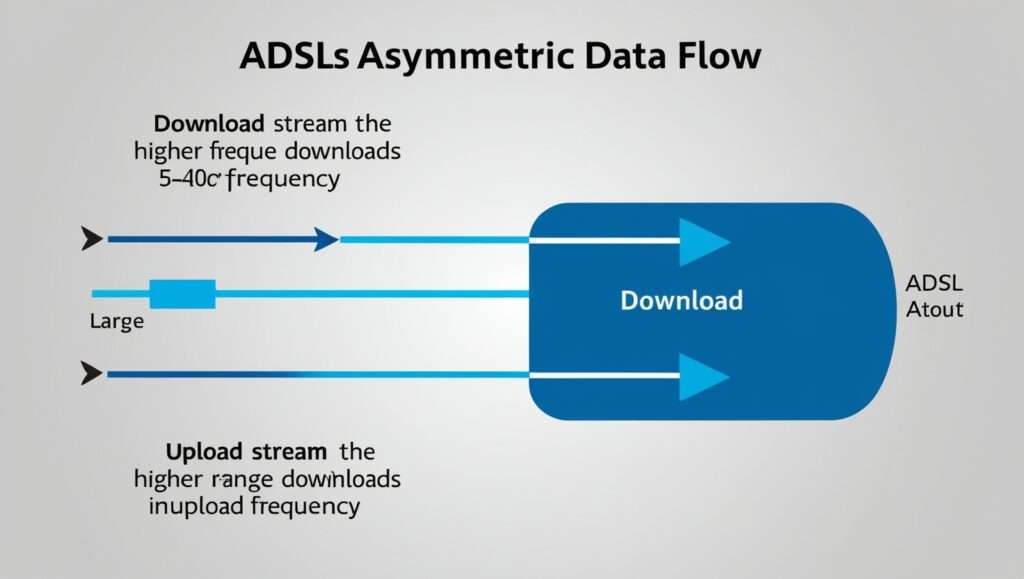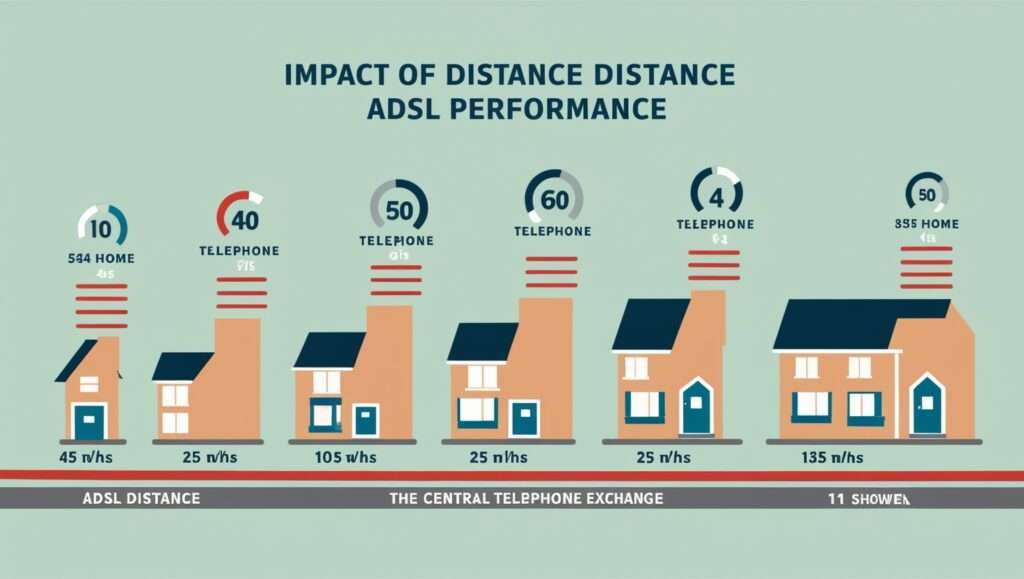Internet connectivity has become a cornerstone of modern life, enabling us to work, learn, and entertain ourselves from virtually anywhere. But have you ever wondered about the technology that powers your home internet? Enter ADSL—or Asymmetric Digital Subscriber Line—a technology that has revolutionized how we connect to the web. Whether you’re streaming your favorite shows, downloading large files, or browsing social media, ADSL plays a crucial role in keeping you connected.
In this guide, we’ll take you through everything you need to know about Asymmetric Digital Subscriber Line (ADSL)—from how it works to its advantages and disadvantages, and even how it compares to other broadband technologies. So, if you’re curious about how your internet works and why ADSL might be the right choice for you, read on!
SEE ALSO : TMC Full Form Explained: Everything You Should Know
What is ADSL(Asymmetric Digital Subscriber Line)?
Let’s start with the basics: What is ADSL?
Asymmetric Digital Subscriber Line (ADSL) is a type of broadband internet connection that uses existing telephone lines to deliver high-speed data to your home. The term “asymmetric” refers to the fact that ADSL provides faster download speeds than upload speeds, which aligns with how most of us use the internet. Whether you’re watching videos, shopping online, or checking emails, ADSL offers a reliable and cost-effective way to stay connected.
How Does ADSL(Asymmetric Digital Subscriber Line) Work?
ADSL might sound complex, but it’s built on a simple concept. Your telephone line—the same one you’ve used for years—has more to offer than just voice calls. ADSL taps into the unused frequencies of your phone line, turning it into a high-speed data highway.
The Role of Telephone Lines
Your standard phone line was originally designed to carry voice signals, which occupy a small part of the available frequency range. ADSL takes advantage of the remaining spectrum, splitting it into two channels: one for data (internet) and one for voice. This means you can use the internet and make phone calls simultaneously without any interference—pretty cool, right?

The Asymmetry Explained
The “asymmetry” in ADSL refers to the imbalance between download and upload speeds. Most of us spend more time downloading—think streaming movies or loading web pages—than uploading, which is why ADSL prioritizes download speeds. This asymmetry makes ADSL perfect for everyday internet users who don’t need super-fast upload speeds.
Why Choose ADSL(Asymmetric Digital Subscriber Line)?
So, why should you opt for ADSL? Here are some compelling reasons:
High-Speed Internet Access 📶
With ADSL, you get high-speed internet without needing to lay down new cables. Speeds can range from 1 Mbps to over 24 Mbps, depending on your location and service provider.
Simultaneous Voice & Data Use 📞💻
One of the biggest perks of ADSL is that it lets you use your phone and the internet at the same time. No more fights over whether to make a call or stay online—ADSL lets you do both without missing a beat.
Cost-Effective Solution 💰
ADSL is often more affordable than other broadband options like fiber optic or cable, especially if you already have a phone line. The installation is straightforward, and you don’t need expensive new equipment. This makes Asymmetric Digital Subscriber Line a budget-friendly choice for families and small businesses.
The Limitations of ADSL(Asymmetric Digital Subscriber Line)
While ADSL has plenty of benefits, it’s not without its limitations. Here are a few things to consider:

Distance Sensitivity 📏
ADSL’s performance can be affected by the distance between your home and the nearest telephone exchange. The further away you are, the weaker your signal, which can result in slower speeds. This is one of the biggest challenges with ADSL, especially in rural areas.
Slower Upload Speeds 🚶♂️
Remember the “asymmetric” part of ADSL? While it’s great for downloading, uploading can be a bit slower. If you’re a content creator or someone who needs to upload large files regularly, this could be a drawback.
Susceptibility to Interference 🌩️
Because ADSL uses copper telephone lines, it can be prone to interference from electrical devices and weather conditions. This can occasionally lead to dropped connections or slower speeds, though modern technology has mitigated this to some extent.
ADSL vs. Other Technologies
How does ADSL stack up against other broadband technologies? Let’s take a look:
ADSL vs. SDSL 🆚
SDSL (Symmetric Digital Subscriber Line) offers equal download and upload speeds, making it ideal for businesses that need to send large files frequently. However, SDSL is usually more expensive and less widely available than ADSL, making it less appealing for everyday users.
ADSL vs. Cable 🆚
Cable internet typically offers faster speeds than ADSL, especially for downloads. However, cable connections are shared among multiple users in a neighborhood, which can slow down speeds during peak times.
ADSL vs. Fiber Optic 🆚
Fiber optic broadband is the gold standard when it comes to speed, offering lightning-fast downloads and uploads. However, it’s also more expensive and may not be available in all areas. ADSL remains a solid alternative where fiber hasn’t yet been rolled out.
Is ADSL(Asymmetric Digital Subscriber Line) Right for You?
Asymmetric Digital Subscriber Line is an excellent choice for:
- Residential Users: If you’re a casual internet user who primarily streams, browses, and shops online, ADSL offers more than enough speed and reliability.
- Small Businesses: For small businesses that don’t require heavy uploading or ultra-fast speeds, ADSL provides a cost-effective solution for day-to-day operations.
However, if you need super-fast upload speeds or live far from the telephone exchange, you might want to explore other options.
The Future of ADSL(Asymmetric Digital Subscriber Line)
As technology advances, so too does ADSL. The introduction of ADSL2 and ADSL2+ has pushed speeds even higher, making it a competitive option in the broadband market. While fiber optic and other technologies are gaining ground, ADSL continues to evolve, offering reliable service to millions.
How to Set Up ADSL at Home
Setting up ADSL at home is easier than you might think. Here’s a quick guide:
Choosing the Right Provider 📜
Start by comparing ADSL providers in your area. Look for a package that offers the best balance of speed, reliability, and cost. Don’t forget to check customer reviews!
Installation Tips 🔧
Once you’ve chosen a provider, they’ll usually send a technician to set up your connection. You’ll need an ADSL modem and a microfilter to separate voice and data signals on your line. After that, you’re good to go!
Final Thoughts
Asymmetric Digital Subscriber Line (ADSL) remains a reliable, affordable, and widely available option for internet users. While it has its limitations, especially in terms of distance and upload speeds, it’s a fantastic choice for most households and small businesses. As technology continues to improve, ADSL will likely remain a key player in the broadband market, keeping people connected all over the world.
So, whether you’re setting up your first home internet connection or looking for a more budget-friendly option, ADSL could be the perfect solution. With its blend of speed, affordability, and ease of use, it’s no wonder millions of people rely on ADSL to stay online.
Ready to connect? Choose ADSL and experience the power of Asymmetric Digital Subscriber Line technology today! 🌐✨
Note: For those who are interested in upgrading or comparing other broadband services, it’s always good to explore all options. But remember, ADSL offers a solid, dependable choice for the vast majority of users!
FAQs:
ADSL stands for Asymmetric Digital Subscriber Line, which means it offers higher download speeds compared to upload speeds. Other types of DSL, such as SDSL (Symmetric Digital Subscriber Line), provide equal download and upload speeds.
ADSL can provide download speeds of up to 24 Mbps, depending on your distance from the telephone exchange. However, fiber optic internet is significantly faster, offering speeds that can reach 1 Gbps or more.
Yes, ADSL allows for simultaneous use of your phone and internet connection. The technology separates voice and data signals, so you can make phone calls without interrupting your internet usage.
The speed of your ADSL connection can be affected by the distance from your home to the nearest telephone exchange, the quality of your phone line, and potential interference from electrical devices.
Yes, ADSL can handle online gaming and video streaming, especially if your connection speed is at the higher end of the ADSL spectrum. However, if multiple devices are streaming or gaming simultaneously, you might experience slower speeds.
Our Latest Posts:
- 🔒 How to Protect Your Phone from Hidden Malware: Complete Guide 2025
- What Are Gen Z & What Generation Is Z? A Complete Guide
- The Ultimate Guide: What Is the Longest in the World? 🌍
- Machine Learning Time Series Regressions with an Application to Nowcasting
- आर्टिफिशियल इंटेलिजेंस के बारे में: एक सरल दृष्टिकोण 🤖




3 thoughts on “ADSL Unleashed: 9 Reasons Why Asymmetric Digital Subscriber Line Will Rock Your Internet World🚀”